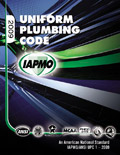
Over three days in April, a major rewrite of the Uniform Plumbing Code (UPC) unfolded. A large number of the more than 250 proposed changes were submitted by the Code Correlating Committee, which had the daunting task of updating all the language in the UPC.
Many of the correlation changes, however, did not affect the technical content of the code. The changes will make the code easier to understand and use.
A comment I often hear from engineers is, “If that is what the code means, why doesn’t it just say that?” With the correlation changes, the code will now “just say it.” Another benefit to these changes will be consistency with interpretations. The intent of the code is to be interpreted the same, no matter the location of the construction project.

Water Reuse and Reclaimed Water
One of the largest changes to the UPC is the complete rewrite of Chapter 16 on water reuse and reclaimed water. When Chapter 16 was updated in the 2009 code, it was identified as still needing a major overhaul. This update was tackled by the Green Code Committee.The new chapter will allow for four different alternate water sources: reclaimed (recycled) water; rainwater; graywater; and onsite, treated, nonpotable water. Reclaimed water is a term reserved for publically supplied nonpotable water (controlled and tested by the wastewater utility). The remaining three categories are green systems provided and maintained by the building owner.
Rainwater has the fewest restrictions of all the nonpotable water sources used inside the building. No treatment of rainwater is required for storage systems of less than 360 gallons used for irrigation. When used for flushing water closets and urinals, the rainwater must have a debris excluder. There must also be a 100-micron mesh filter on the water supply. Disinfection, if necessary, is specified by the jurisdiction.
Graywater is still limited in its use to subsurface or subsoil irrigation systems. The requirements are similar to the current requirements in the UPC.
Onsite, treated, nonpotable water was the most discussed topic at the hearing. There was confusion regarding what types of water were permitted in this category. Some of the testimony claimed rainwater and blackwater could not be included, and treatment would thus be limited to only graywater.
This was clarified as being an incorrect interpretation. In fact, onsite, treated, nonpotable water can be a water supply originating from any source. The key requirement is the disinfection and treatment of this water supply.
One of the great requirements of Chapter 16 is the table identifying the minimum maintenance and inspection schedule for an alternate water source - a contentious issue with new systems. With it clearly spelled out in the code, every building owner is aware of when period maintenance must be performed.
In addition to nonpotable water uses, a new appendix was approved on potable rainwater catchment systems. These are systems similar to those found on many islands. There are restrictions on the areas permitted for rainwater catchment, and the rainwater would have to be disinfected to meet water-quality requirements.
The code meeting did have its share of controversy in other areas. Non-water supplied urinals are acceptable under the UPC, however there was a proposal to expand that approval to include non-water supplied urinals that do not have a trap. The drain is closed off by a barrier membrane.
This change was recommended for rejection with the reason given that a membrane is not equivalent to a liquid seal trap in providing protection of the inside environment from the drainage system.
Valves and PEX Tubing
There were multiple changes to add air-admittance valves to the code. One change would allow individual and branch-type air-admittance valves in Chapter 9. The other would allow any type of air-admittance valve as an engineered system in Appendix L. The committee approved both changes.Additionally, a change was proposed to remove PEX tubing and PEX-AL-PEX tubing from the code based on a number of failures in Nevada. It was pointed out many of these failures were with brass fittings and could be traced to poor water quality. Others claimed the tubing was also failing.
The committee voted to reject the changes, indicating PEX has proven to be a viable piping material used throughout the country. While some failures have occurred, there was no technical justification for removing the material from the code.
New piping materials recommended to be included in the code were raised-temperature polyethylene and polypropylene tubing.
Water Savings
A number of changes would have made an impact on water savings. Included were reduction in water use to a 1.28 gpf water closet, 1.5 gpm lavatory faucets and 0.5 gpf urinals. All of these changes were rejected with the concern the code cannot conflict with the federal requirements on water conservation.A water-conserving measure that was approved would limit commercial food-service pre-rinse valves. The flow rate would be restricted to 1.6 gpm under the new requirements.
The reduction in fixture flow rates was also included in a green plumbing code supplement. The supplement would become Appendix M. This would become a voluntary supplement to encourage sustainable practices in plumbing. This appendix was approved for inclusion in the code.
The code changes can be downloaded atwww.iapmo.org. The next part of the process is the comment period (voicing opposition to committee recommendations). The comments will be reviewed at next May’s meeting in St. Louis.

